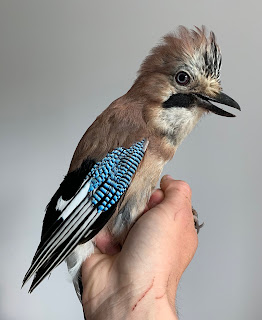This week we gathered a team to clear net rides in the
reed bed of one of our most productive sites, situated in the Yare Valley. Over
the weekend we had our first sessions on site since clearing the net rides, and
was the first sessions on site this year. The site has a long history of bird
ringing activity, and enables us to monitor populations of your typical reed bed
passerines, and a few stars of the show. With plenty of eager helpers in the group, we're hoping for a bumper year of ringing on site this season.
We ran two ringing sessions this weekend, one on late Saturday
afternoon leading into an evening Swallow roost catch and a second session the
following morning. We caught 232 birds
over the two sessions across 9
species. 75 these birds were Swallows caught into roost and all were this year’s
juvenile birds. This can probably be attributed to most adults currently tending
to their second broods, rather than roosting in the reed bed. Surprisingly the
roost catch didn’t produce any wagtails, despite hearing Yellow Wagtails in the
reed bed earlier in the evening. This may be an indication that the larger
roosting numbers are yet to build this year.
The most exciting surprise of the weekend came in the shape
of a Reed Warbler sporting a shiny
blue British Museum ring. A quick check of DemOn told us it was ringed on the
9th January this year, our interests peaked and a phone call later, we realised
we were looking at a Gambian control! Of course every adult reed warbler we
handle has made a trip from Sub-Saharan Africa, but one sporting a Gambian ring
is something special. The bird was ringed at Kartong Bird Observatory as part of a BTO supported project that targets ringing of Western Palearctic migrants. When you consider the far lower density of ringers in Africa compared to what we are accustomed to in Europe, the huge numbers of individuals that undertake these journeys, and the massive spatial scale, it's a pretty exciting control!
Figure 1. Roughly 4,600km from The Gambia to Norwich, it's a long flight for a ~12g bird
Whilst they are an expected catch on most sessions on site, Bearded Tits are always a welcome catch
and were a particular treat for those in the group that haven’t experienced the
species before. With 22 caught,
numbers on site at first impression seem healthy and with 13 of the 22 individuals
being juveniles it seems like another successful breeding season. Other highlights included singles of Garden Warbler, Whitethroat, and Greenfinch.
The latter a species both trainers in the group, who have ringed this site for
many years, couldn’t recall being caught here before. Being a juvenile male, it
is perhaps a dispersing individual.
Diurnal passerine numbers in the reed bed seemed in good
stead in general, and hopes are high for many more productive sessions at the
site over the coming months.
Table 1. Capture
over two sessions 3-4th August 2019. Number of juveniles in
brackets.
Species
|
New
|
Retraps
|
Total
|
Bearded tit
|
22 (13)
|
0
|
22
|
Garden Warbler
|
1 (1)
|
0
|
1
|
Greenfinch
|
1 (1)
|
0
|
1
|
Reed Bunting
|
9 (5)
|
0
|
9
|
Reed Warbler
|
97 (65)
|
2 (0)
|
99
|
Sedge Warbler
|
21 (21)
|
1 (1)
|
22
|
Swallow
|
76 (76)
|
0
|
76
|
Whitethroat
|
1 (1)
|
0
|
1
|
Wren
|
1 (0)
|
0
|
1
|
Total
|
229
|
3
|
232
|
This juvenile female Bearded
Tit was just one of 13 juveniles caught across the two sessions. Like most
of the juveniles she was undergoing a complete moult (hence why it she’s a
little scruffy), one of the relatively few British passerines that do so.
The most abundant reed bed passerine on site, the Reed Warbler. The two sessions saw us
catch 99 individuals.
The star of the show, a Gambian ringed Reed Warbler. The blue anodised metal rings were originally used in the UK
for a House Martin project that aimed to increase recovery rates, but
remaining rings after the project ended were given to the Gambian ringing scheme.
A juvenile Sedge Warbler,
showing the ‘necklace’ of black spots seen in juveniles.













